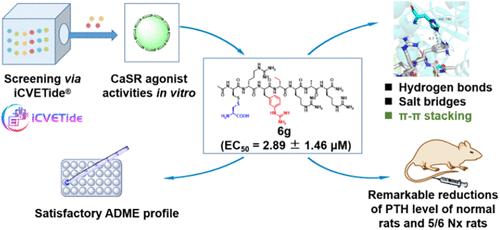通过多阶段筛选发现CaSR肽激动剂:计算机设计、体外验证和体内疗效
IF 6.8
1区 医学
Q1 CHEMISTRY, MEDICINAL
引用次数: 0
摘要
人钙敏感受体(CaSR)是一种C类G蛋白偶联受体(GPCR),直接调节甲状旁腺激素释放,维持钙稳态。利用计算机辅助药物设计(CADD)发现有效的CaSR激动剂一直很有吸引力。在此,我们报告了一系列新的CaSR激动剂的发现,这些激动剂通过iCVETide平台通过替换关键残基来增强分子结合亲和力。发现了具有良好活性和良好ADME谱的Ac-D-Cys(L-Cys)- d - arg - d -(3-Gu)- phee - d - abu - d - arg - d - ala - d - arg - nh2(化合物6g),并通过分子对接和分子动力学模拟阐明了6g与CaSR的相互作用模式,表现出氢键、盐桥和π - π堆叠。此外,6g能够作为一种拟钙化正变构调节剂激活人CaSR。我们的研究结果提供了一种可行的替代已批准的煅烧剂,并为发现CaSR激动剂提供了新的方案。本文章由计算机程序翻译,如有差异,请以英文原文为准。

Discovery of CaSR Peptide Agonists via Multistage Screening: In Silico Design, In Vitro Validation, and In Vivo Efficacy
Human calcium-sensing receptor (CaSR) is a class C G protein–coupled receptor (GPCR) that directly regulates parathyroid hormone release and maintains calcium homeostasis. The discovery of potent CaSR agonists with computer-aided drug design (CADD) has been appealing. Herein, we report the discovery of a series of new CaSR agonists by enhancing the molecular binding affinity through the replacement of key residues via the iCVETide platform. Ac-D-Cys(L-Cys)-D-Arg-D-(3-Gu)-Phe-D-Abu-D-Arg-D-Ala-D-Arg-NH2 (compound 6g) with an outstanding activity and a satisfactory ADME profile is discovered, and the interaction mode between 6g and CaSR is elucidated through molecular docking and molecular dynamics simulations, showing hydrogen bonds, salt bridges, and π–π stacking. In addition, 6g is capable of activating human CaSR as a calcimimetic positive allosteric modulator. Our results provide a viable alternative to approved calcimimetics and a novel protocol for the discovery of CaSR agonists.
求助全文
通过发布文献求助,成功后即可免费获取论文全文。
去求助
来源期刊

Journal of Medicinal Chemistry
医学-医药化学
CiteScore
4.00
自引率
11.00%
发文量
804
审稿时长
1.9 months
期刊介绍:
The Journal of Medicinal Chemistry is a prestigious biweekly peer-reviewed publication that focuses on the multifaceted field of medicinal chemistry. Since its inception in 1959 as the Journal of Medicinal and Pharmaceutical Chemistry, it has evolved to become a cornerstone in the dissemination of research findings related to the design, synthesis, and development of therapeutic agents.
The Journal of Medicinal Chemistry is recognized for its significant impact in the scientific community, as evidenced by its 2022 impact factor of 7.3. This metric reflects the journal's influence and the importance of its content in shaping the future of drug discovery and development. The journal serves as a vital resource for chemists, pharmacologists, and other researchers interested in the molecular mechanisms of drug action and the optimization of therapeutic compounds.
 求助内容:
求助内容: 应助结果提醒方式:
应助结果提醒方式:


